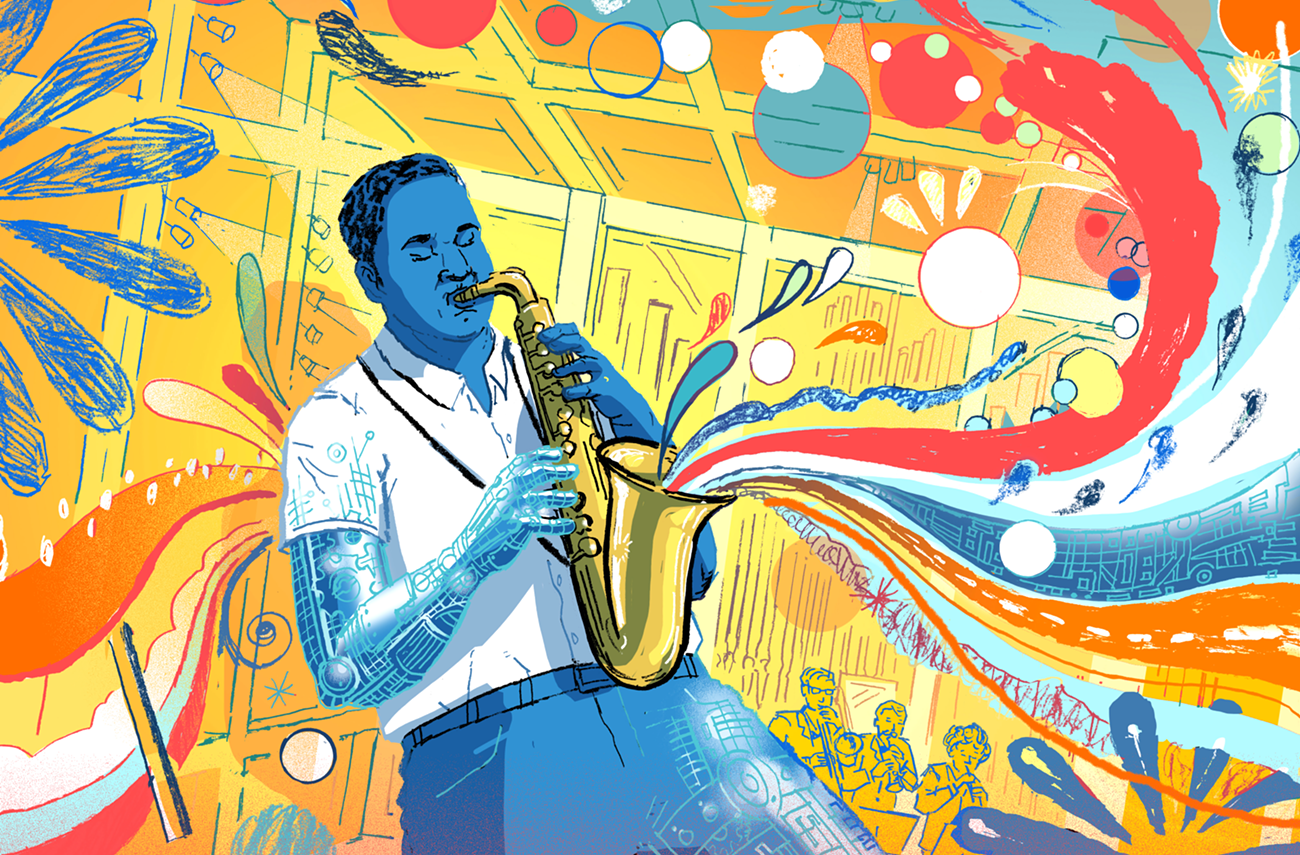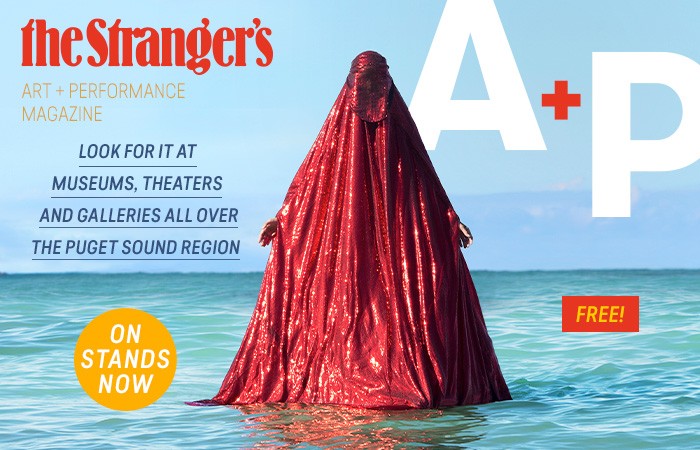What the Hell Is Make Believe Seattle?
Finally, a Film Festival for Fellow Weirdos
The Power of Making People of Color Invisible
Stephanie Syjuco Empowers the Oppressed with Just a Finger
Better, Stronger, Faster
The Seattle Repertory Jazz Orchestra Pays Tribute to the Legendary Oliver Nelson
Where to Pickup a Copy of The Stranger's Spring A+P 2024
Find it at Hundreds of Locations Around Seattle!
Queen of Our World
When Sasha taqwšəblu LaPointe Writes, the Revolution’s Coming
Blowing Minds and Melting Faces
Thunderpussy Celebrate Their Survival with a Surprising Benaroya Hall Takeover
Person of Interest: Arson Nicki
Finally, a Fashion Expert for the People
Six Films You Need to See at Make Believe Seattle
Starring Ethical Vampires, Ridiculous Puppets, and a Dude Who Pretends to Be George Lucas for Funsies
Art, Illness, and Auto Repair
Cherdonna Makes a Compassionate Comeback
Person of Interest: TeZATalks
Harbinger of Horror-Filled Hardcore Pop
It’s Important That the Bug Undulates
How Anida Yoeu Ali Uses Wiggling Worms and Glitter as Forms of Protest
Sincerely Joking
Chastity Belt Live, Laugh, and Love 10 Years On
Your Spring Arts Itinerary
24 of This Season’s Very Best Art, Books, Music, Film, Theater, and Food Events
Tessa Hulls’s Feeding Ghosts Is Instant Canon Fodder
Too Bad She’ll Never Write Another Graphic Novel
Isabel Hagen’s Comedy Strings You Along
How a Juilliard-Trained Violist Found Harmony as a Stand-Up Comedian
Person of Interest: Taha Ebrahimi
Seattle’s Coolest Street Tree Expert
Let’s begin with The Six Million Dollar Man. The TV show ran from 1973 to 1978. The star, Lee Majors, played an astronaut who, after his body is damaged in the crash of a test plane/spaceship, is transformed, with the top technology of the day, into a cyborg: part human but mostly wires, circuits, metal gears, and synthetic skin. The operation cost $6 million (roughly equal to $40 million in today’s money). The opening for the show is just mesmerizing.
After the test craft hits the ground and explodes, an off-camera narrator, Oscar Goldman, speaks to the members of a secret government agency with the deepest pockets. He says: “Gentlemen, we can rebuild him. We have the technology. We have the capability to make the world’s first bionic man. Steve Austin will be that man. Better than he was before. Better… stronger… faster.” At the last word, the show’s theme erupts into accelerating bongos, whirling and blasting horns, and a hard-funk bass line. By the end of the sequence, you are sold. Indeed, the show could never be as good as that opening: Lee Majors’s fast-motion running to a funky beat. It has to be downhill from there. But no matter. All of the garbage in the show had nothing on the music, which was written and produced by one of jazz’s greatest intellectuals, Oliver Nelson.
This arranger, composer, conductor, and saxophonist also made, in 1961, the jazz classic The Blues and the Abstract Truth, a work that is everything that The Six Million Dollar Man theme is not. It is not the kind of music that can capture the incredible speed of a human/machine. Its structure, pace switches, and harmonic innovations are too heady for that sort of entertainment. Here we are presented with the art of a highly educated musician.
In the late ‘50s, Nelson studied composition and music theory at universities in his hometown, St. Louis, Missouri. (He also studied, according to an article on JazzProfiles, “taxidermy and embalming” because his family was “in the funeral home business.”) A few years after obtaining a master’s degree in music, Nelson released his first masterpiece, The Blues and the Abstract Truth, which featured some of the best jazz musicians of the time—Freddie Hubbard, Eric Dolphy, Bill Evans, and Paul Chambers—and contained the definitive version of Nelson’s most famous piece of music, “Stolen Moments.” After that work, his future in the funeral business closed permanently. The rest of his life, which was tragically short (a heart attack killed him at the age of 43), was devoted to writing, conducting, and arranging music during jazz’s modern period (the 1960s) and composing scores for movies and TV shows. Had he lived a long life, there is no doubt that his name would be as recognizable, as mainstream as Quincy Jones.
“You know, I just love Blues and the Abstract Truth, I just love the way it bounces around to different meters and the angularity of the melody, and the sound of the ensemble—all of these things appeal to me greatly,” says Michael Brockman, the artistic director of Seattle Repertory Jazz Orchestra (SRJO). We are on the phone. We are talking about the orchestra’s upcoming tribute to Oliver Nelson, “SRJO Plays Blues and the Abstract Truth.” A few moments before, Brockman, who founded SRJO with Clarence Acox in 1995, said Nelson is one of “the leading icons in the history of jazz. And, in the jazz industry, he’s recognized as one of the people who established the art form into something composers could take part in.” SRJO is primarily devoted to the work of composers—”Charles Mingus, Gil Evans, Thelonious Monk... and of course, Count Basie and Duke Ellington.”
Indeed, one of the best musical shows I experienced last year was “SRJO Plays Charles Mingus.” It happened on February 11 at Benaroya Hall. The players, many of whom will be on the stage for “SRJO Plays Blues and the Abstract Truth,” were just in top form. Mingus had a spirit that was as huge as it was singular. For musicians, even our city’s best ones (Randy Halberstadt, D’Vonne Lewis, Kate Olson, Jay Thomas), to successfully capture that singularity and even revisit the extraordinary expansiveness of the composer was nothing less than remarkable. The performance made it very clear to me that SRJO is not just one of our city’s core jazz institutions but one of its most vital art institutions.
“For the [“SRJO Plays Blues and the Abstract Truth”] show, we’re going to do most of the pieces from the original album [The Blues and the Abstract Truth] and the second album [More Blues and the Abstract Truth],” says Brockman near the end of the interview. “So we’ll do ‘Stolen Moments,’ ‘Hoe-Down,’ and ‘Cascades.’ I’m still considering whether to do the entire [first] album or draw from music from his other records, but we will definitely play Blues and the Abstract Truth.”
But what about the theme for The Six Million Dollar Man? He does not answer the question because he never heard it; it never left my mind. The Blues and the Abstract Truth is for this great orchestra; the theme for the battery-charged android is for me and my American childhood.
The Seattle Repertory Jazz Orchestra will perform “SRJO Plays Blues and the Abstract Truth” at Benaroya Hall Saturday, April 20, at 7:30 pm. Tickets are available at srjo.org.
View this post on Instagram




















